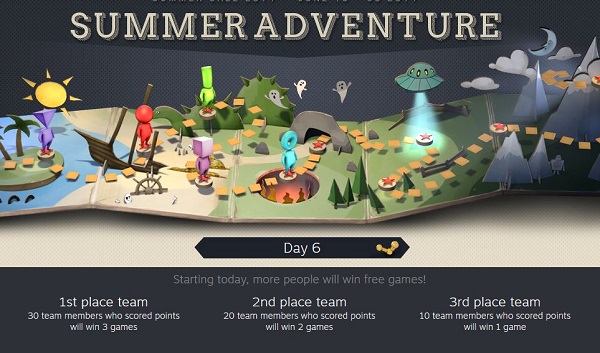
Steam’s Summer Sale has dealt the usual massive amount of damage to wallets. The badge crafting meta-game has also returned to entice the collectors in us to buy even more games and participate in the voting events. This summer, Steam added extra mechanics to encourage gamers to spend more, and maybe interact with each other. Mostly, it just gave Gabe Newell more money to sleep on.
The principles of gamification have been applied to many different tasks with varying amounts of success, although it has never been used in such an efficient and ruthless manner with the introduction of the Steam Summer Adventure. Each Steam user who joined the Steam Summer Adventure was randomly assigned to a team. These teams competed with one another to earn daily points. Points that would only be earn by crafting badges; which require trading cards. At the end of the day, the team with the most points earned a reward.
However, the catch was that the winning team was not rewarded evenly. Only 30 members of each team received free games, while the rest only ended up with trading cards for their efforts.
What this shows is that Valve is very much the master of microtransactions. It has managed to implement it in a platform that is already designed to sell you things. Microtransactions attached to full-blown transactions; all hidden behind a fun game that takes advantage of the need to collect things, fill bars, and obtain the small chance of getting something for free.
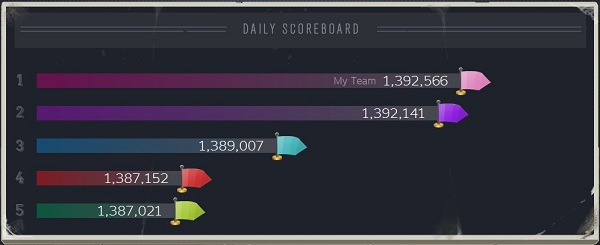
Collecting things on Steam is nothing new. People have become used to seeing random cards drop from their games. Maybe even occasionally assembling a collection big enough to possibly sell some cards to make a small profit. The true genius of the Summer Adventure was how it was presented. The bar charts were updated in real time to allow people to see how their teams were doing, and note just how small their bar is compared to everyone else.
The display beneath it informing people of which teams their friends are on and how many points they have contributed to the cause also spurs people to join the game. This sort of thing is nothing new. RPGs have long used the filling of bars to encourage players to continue playing as a Skinner box experiment. Running numbers have also been a long time staple of video games to allow that competitive spirit to thrive in the form of high scores and the feeling of achievement when a score beats other people.
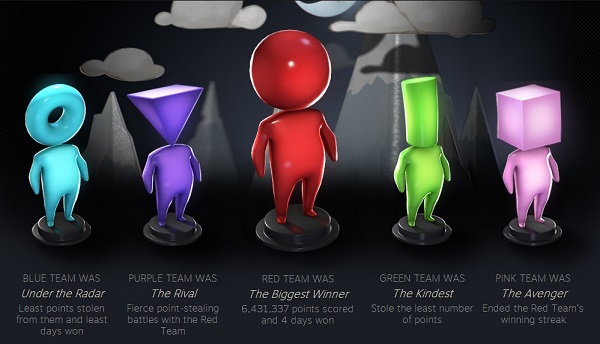
What has happened is that the theory behind making addictive games has been applied to a sale of products, and gamers fell for it. Although, what choice did they have? It was social engineering at its finest. People ended up buying games simply to accumulate enough cards to craft badges.
There are no numbers to indicate whether the Steam Summer Adventure made a difference to the amount of games bought. That may not even have been Valve’s game plan. It could have simply have been to stimulate trading in the Community Market, where they are able to charge an extra 15% on top of the asking price from the seller. If it was, this was a masterstroke from Gabe Newell’s gaming empire.
Each of the Steam Summer Adventure trading cards were sold – on average – some 50,000 times each. While the initial price hit a high of 50 cents, it eventually settled at a more reasonable 25 cents. Considering that there were 10 different cards to collect; taking 2 cents from each sale would have made Valve some US$10,000 from the buying and selling of what is effectively nothing. It doesn’t sound like a lot, but that number does not take into account the other cards from games that were sold during that time.
Some may defend the Summer Adventure as a spot of harmless fun. A game to entertain customers while they do the same shopping they would normally do in this sort of thing. Except that the adventure is effectively the accumulation of item drops from CS: GO and Dota 2; the Hat crafting of Team Fortress 2; and the worst parts of the lottery system.
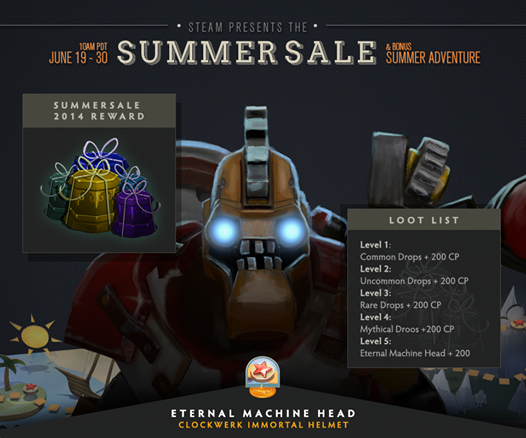
Players wouldn’t notice because at the end of it all they would both earn points for their team and a random item drop from one of the participating games. If you were really lucky, you would receive a rare item for Dota 2; which can again be sold for more money.
Those who wonder why Valve has not made a new game in years should just attempt to do the math on how much they make from the trading that goes on in the Community Market. The thing is, this behaviour does not address the issues that are going on with Steam itself.
Gamers do not need much to buy a lot of games in a sale, they just need plenty of good games to buy. Instead, the most recent sale did not feature any game that has not already been extremely discounted in the past 6 months. When a gaming community is asked to vote between audio and animation software, something has gone horribly wrong.
It could be that Steam sales are losing that special feeling because there is always a sale going on at some point. There are weekly sales that rotate every Monday, Mid-week sales, weekend sales, and sales to commemorate any number of American events. Perhaps there is a little sale fatigue when it comes to Steam.
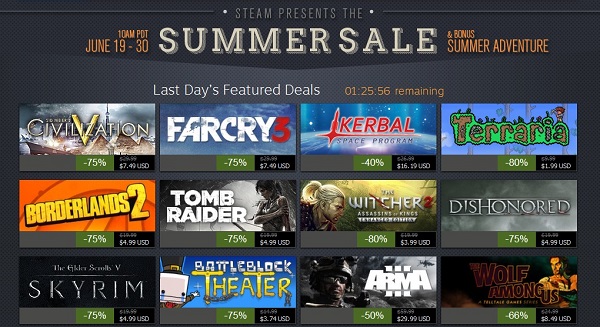
If this is a sign of things to come from future Steam Sales, it might just be easier to accumulate games on discount over the rest of the year. It would be easier than checking into Steam every 8 hours.
Not everyone is pleased with how the sale turned out, although this would be a great time for Valve to announce Half Life 3 to make it up to us.

